Analysis of Woolworths International Business Strategies Report
VerifiedAdded on 2019/10/18
|10
|2706
|338
Report
AI Summary
This report provides a comprehensive analysis of Woolworths' international business operations. It begins with an introduction to relevant economic theories, including international trade and foreign direct investment, and their application to Woolworths' business model. The report then assesses the strengths and weaknesses of Woolworths' proposed business model, focusing on customer-centric strategies and future expansion plans, while also acknowledging limitations such as the lack of online sales development. It further explores market entry strategies, such as direct exporting, licensing, franchising, and joint ventures, emphasizing the importance of leadership, marketing, and human resources in successful international ventures. The impact of global competition on the business model, including potential falls in profits and reduced exports, is also examined. Finally, the report evaluates the key characteristics of a country, such as entry barriers and growth prospects, that Woolworths should consider when expanding its business model. The analysis incorporates various academic references to support the arguments presented.
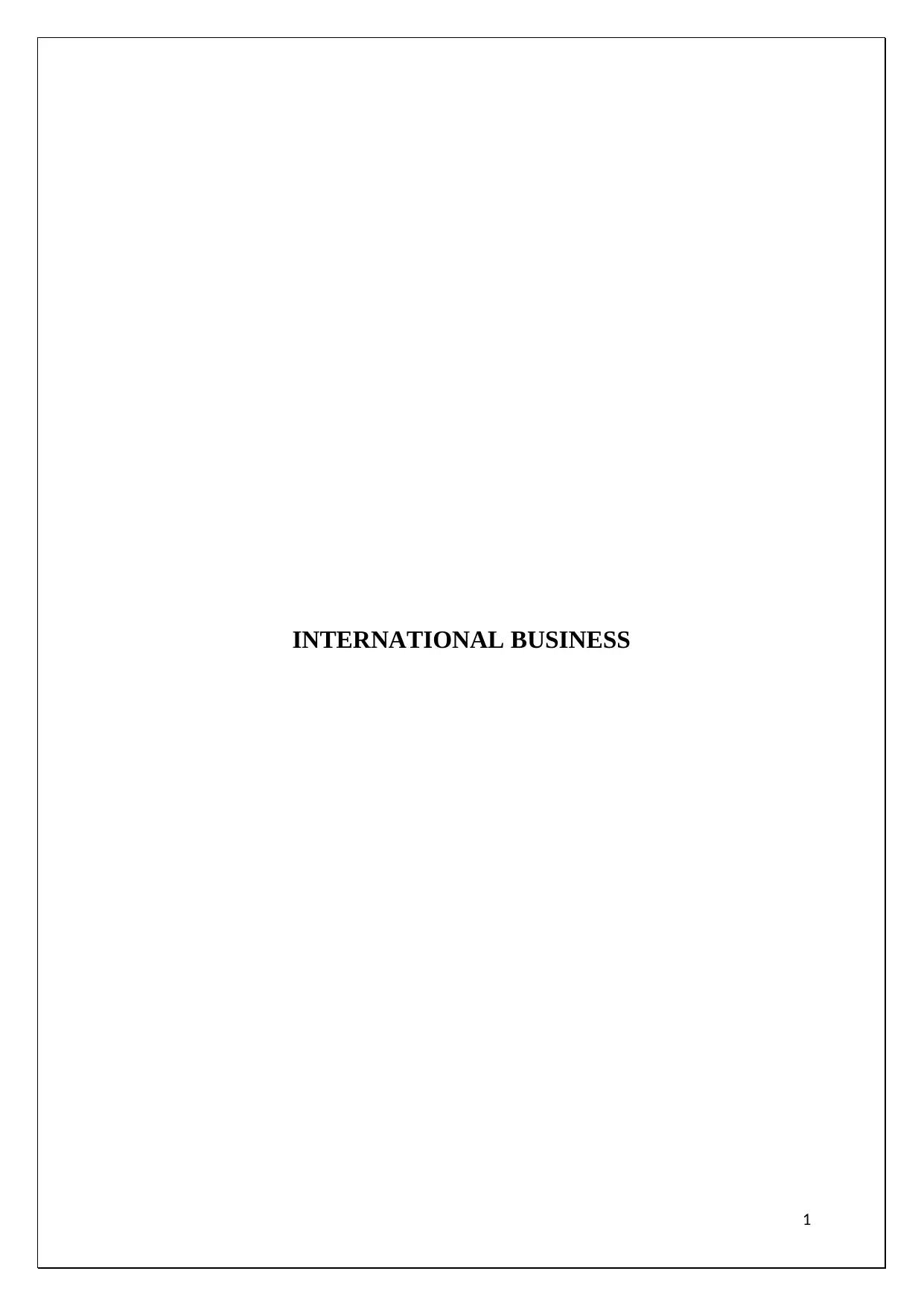
INTERNATIONAL BUSINESS
1
1
Paraphrase This Document
Need a fresh take? Get an instant paraphrase of this document with our AI Paraphraser
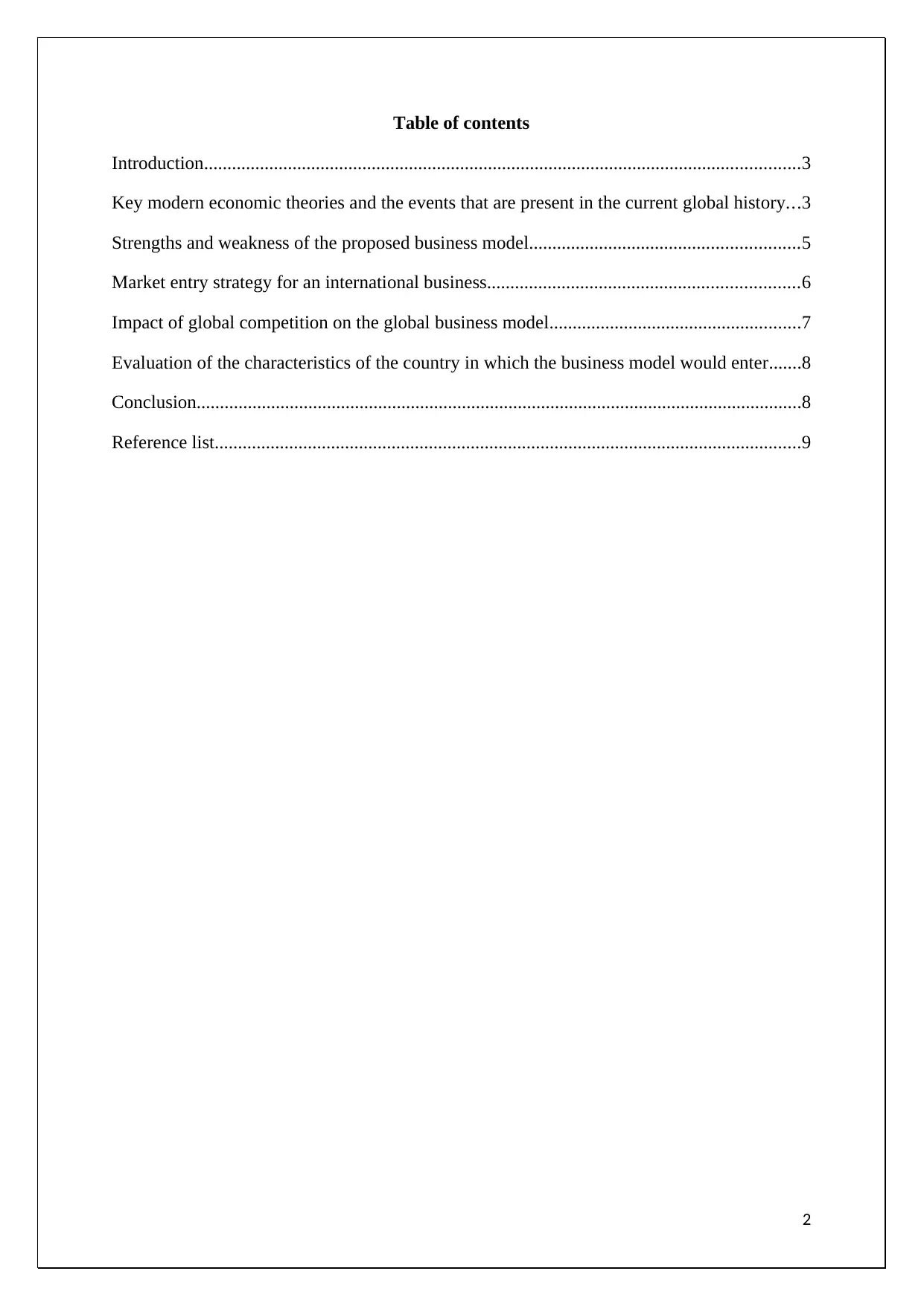
Table of contents
Introduction................................................................................................................................3
Key modern economic theories and the events that are present in the current global history...3
Strengths and weakness of the proposed business model..........................................................5
Market entry strategy for an international business...................................................................6
Impact of global competition on the global business model......................................................7
Evaluation of the characteristics of the country in which the business model would enter.......8
Conclusion..................................................................................................................................8
Reference list..............................................................................................................................9
2
Introduction................................................................................................................................3
Key modern economic theories and the events that are present in the current global history...3
Strengths and weakness of the proposed business model..........................................................5
Market entry strategy for an international business...................................................................6
Impact of global competition on the global business model......................................................7
Evaluation of the characteristics of the country in which the business model would enter.......8
Conclusion..................................................................................................................................8
Reference list..............................................................................................................................9
2
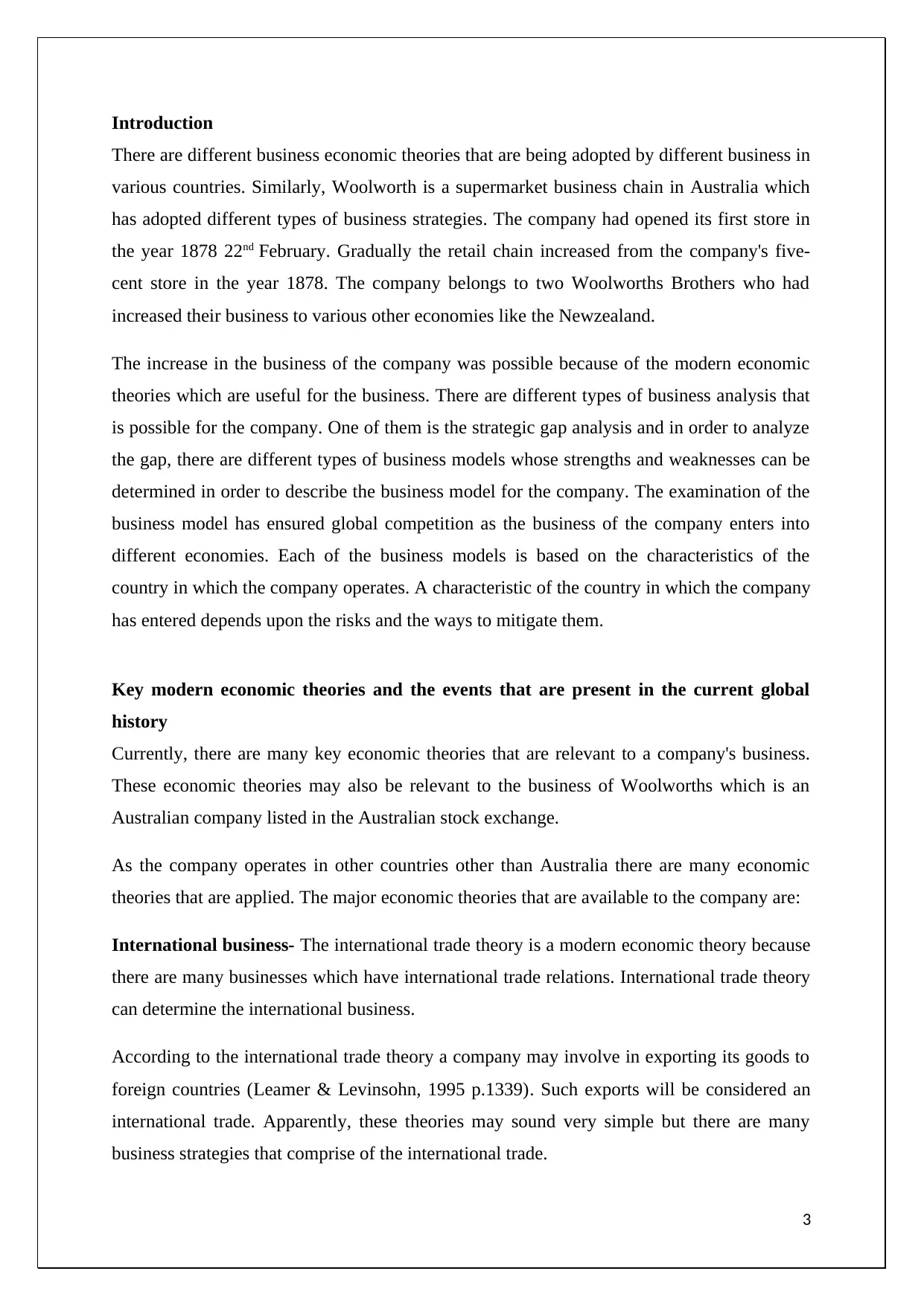
Introduction
There are different business economic theories that are being adopted by different business in
various countries. Similarly, Woolworth is a supermarket business chain in Australia which
has adopted different types of business strategies. The company had opened its first store in
the year 1878 22nd February. Gradually the retail chain increased from the company's five-
cent store in the year 1878. The company belongs to two Woolworths Brothers who had
increased their business to various other economies like the Newzealand.
The increase in the business of the company was possible because of the modern economic
theories which are useful for the business. There are different types of business analysis that
is possible for the company. One of them is the strategic gap analysis and in order to analyze
the gap, there are different types of business models whose strengths and weaknesses can be
determined in order to describe the business model for the company. The examination of the
business model has ensured global competition as the business of the company enters into
different economies. Each of the business models is based on the characteristics of the
country in which the company operates. A characteristic of the country in which the company
has entered depends upon the risks and the ways to mitigate them.
Key modern economic theories and the events that are present in the current global
history
Currently, there are many key economic theories that are relevant to a company's business.
These economic theories may also be relevant to the business of Woolworths which is an
Australian company listed in the Australian stock exchange.
As the company operates in other countries other than Australia there are many economic
theories that are applied. The major economic theories that are available to the company are:
International business- The international trade theory is a modern economic theory because
there are many businesses which have international trade relations. International trade theory
can determine the international business.
According to the international trade theory a company may involve in exporting its goods to
foreign countries (Leamer & Levinsohn, 1995 p.1339). Such exports will be considered an
international trade. Apparently, these theories may sound very simple but there are many
business strategies that comprise of the international trade.
3
There are different business economic theories that are being adopted by different business in
various countries. Similarly, Woolworth is a supermarket business chain in Australia which
has adopted different types of business strategies. The company had opened its first store in
the year 1878 22nd February. Gradually the retail chain increased from the company's five-
cent store in the year 1878. The company belongs to two Woolworths Brothers who had
increased their business to various other economies like the Newzealand.
The increase in the business of the company was possible because of the modern economic
theories which are useful for the business. There are different types of business analysis that
is possible for the company. One of them is the strategic gap analysis and in order to analyze
the gap, there are different types of business models whose strengths and weaknesses can be
determined in order to describe the business model for the company. The examination of the
business model has ensured global competition as the business of the company enters into
different economies. Each of the business models is based on the characteristics of the
country in which the company operates. A characteristic of the country in which the company
has entered depends upon the risks and the ways to mitigate them.
Key modern economic theories and the events that are present in the current global
history
Currently, there are many key economic theories that are relevant to a company's business.
These economic theories may also be relevant to the business of Woolworths which is an
Australian company listed in the Australian stock exchange.
As the company operates in other countries other than Australia there are many economic
theories that are applied. The major economic theories that are available to the company are:
International business- The international trade theory is a modern economic theory because
there are many businesses which have international trade relations. International trade theory
can determine the international business.
According to the international trade theory a company may involve in exporting its goods to
foreign countries (Leamer & Levinsohn, 1995 p.1339). Such exports will be considered an
international trade. Apparently, these theories may sound very simple but there are many
business strategies that comprise of the international trade.
3
⊘ This is a preview!⊘
Do you want full access?
Subscribe today to unlock all pages.

Trusted by 1+ million students worldwide
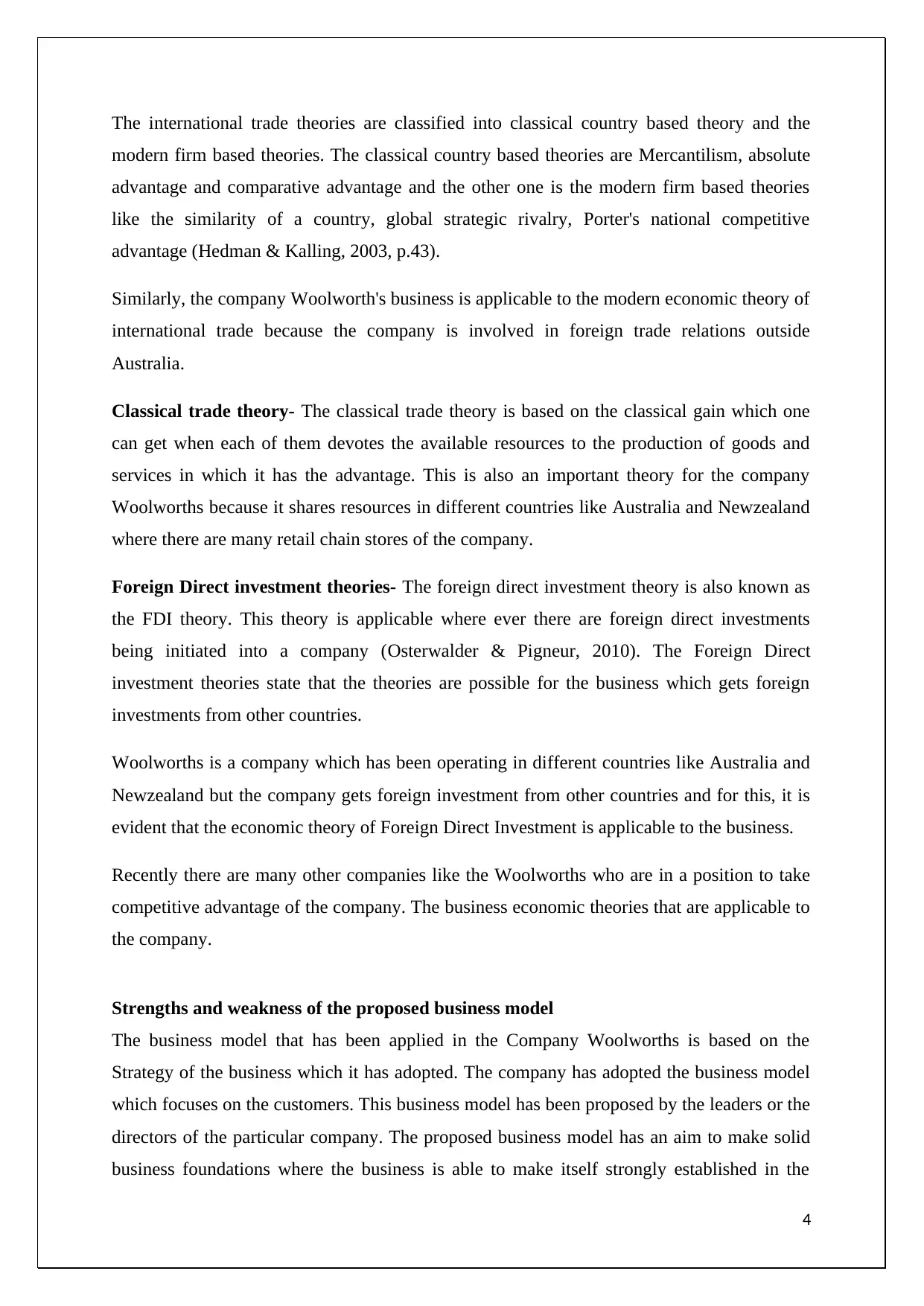
The international trade theories are classified into classical country based theory and the
modern firm based theories. The classical country based theories are Mercantilism, absolute
advantage and comparative advantage and the other one is the modern firm based theories
like the similarity of a country, global strategic rivalry, Porter's national competitive
advantage (Hedman & Kalling, 2003, p.43).
Similarly, the company Woolworth's business is applicable to the modern economic theory of
international trade because the company is involved in foreign trade relations outside
Australia.
Classical trade theory- The classical trade theory is based on the classical gain which one
can get when each of them devotes the available resources to the production of goods and
services in which it has the advantage. This is also an important theory for the company
Woolworths because it shares resources in different countries like Australia and Newzealand
where there are many retail chain stores of the company.
Foreign Direct investment theories- The foreign direct investment theory is also known as
the FDI theory. This theory is applicable where ever there are foreign direct investments
being initiated into a company (Osterwalder & Pigneur, 2010). The Foreign Direct
investment theories state that the theories are possible for the business which gets foreign
investments from other countries.
Woolworths is a company which has been operating in different countries like Australia and
Newzealand but the company gets foreign investment from other countries and for this, it is
evident that the economic theory of Foreign Direct Investment is applicable to the business.
Recently there are many other companies like the Woolworths who are in a position to take
competitive advantage of the company. The business economic theories that are applicable to
the company.
Strengths and weakness of the proposed business model
The business model that has been applied in the Company Woolworths is based on the
Strategy of the business which it has adopted. The company has adopted the business model
which focuses on the customers. This business model has been proposed by the leaders or the
directors of the particular company. The proposed business model has an aim to make solid
business foundations where the business is able to make itself strongly established in the
4
modern firm based theories. The classical country based theories are Mercantilism, absolute
advantage and comparative advantage and the other one is the modern firm based theories
like the similarity of a country, global strategic rivalry, Porter's national competitive
advantage (Hedman & Kalling, 2003, p.43).
Similarly, the company Woolworth's business is applicable to the modern economic theory of
international trade because the company is involved in foreign trade relations outside
Australia.
Classical trade theory- The classical trade theory is based on the classical gain which one
can get when each of them devotes the available resources to the production of goods and
services in which it has the advantage. This is also an important theory for the company
Woolworths because it shares resources in different countries like Australia and Newzealand
where there are many retail chain stores of the company.
Foreign Direct investment theories- The foreign direct investment theory is also known as
the FDI theory. This theory is applicable where ever there are foreign direct investments
being initiated into a company (Osterwalder & Pigneur, 2010). The Foreign Direct
investment theories state that the theories are possible for the business which gets foreign
investments from other countries.
Woolworths is a company which has been operating in different countries like Australia and
Newzealand but the company gets foreign investment from other countries and for this, it is
evident that the economic theory of Foreign Direct Investment is applicable to the business.
Recently there are many other companies like the Woolworths who are in a position to take
competitive advantage of the company. The business economic theories that are applicable to
the company.
Strengths and weakness of the proposed business model
The business model that has been applied in the Company Woolworths is based on the
Strategy of the business which it has adopted. The company has adopted the business model
which focuses on the customers. This business model has been proposed by the leaders or the
directors of the particular company. The proposed business model has an aim to make solid
business foundations where the business is able to make itself strongly established in the
4
Paraphrase This Document
Need a fresh take? Get an instant paraphrase of this document with our AI Paraphraser
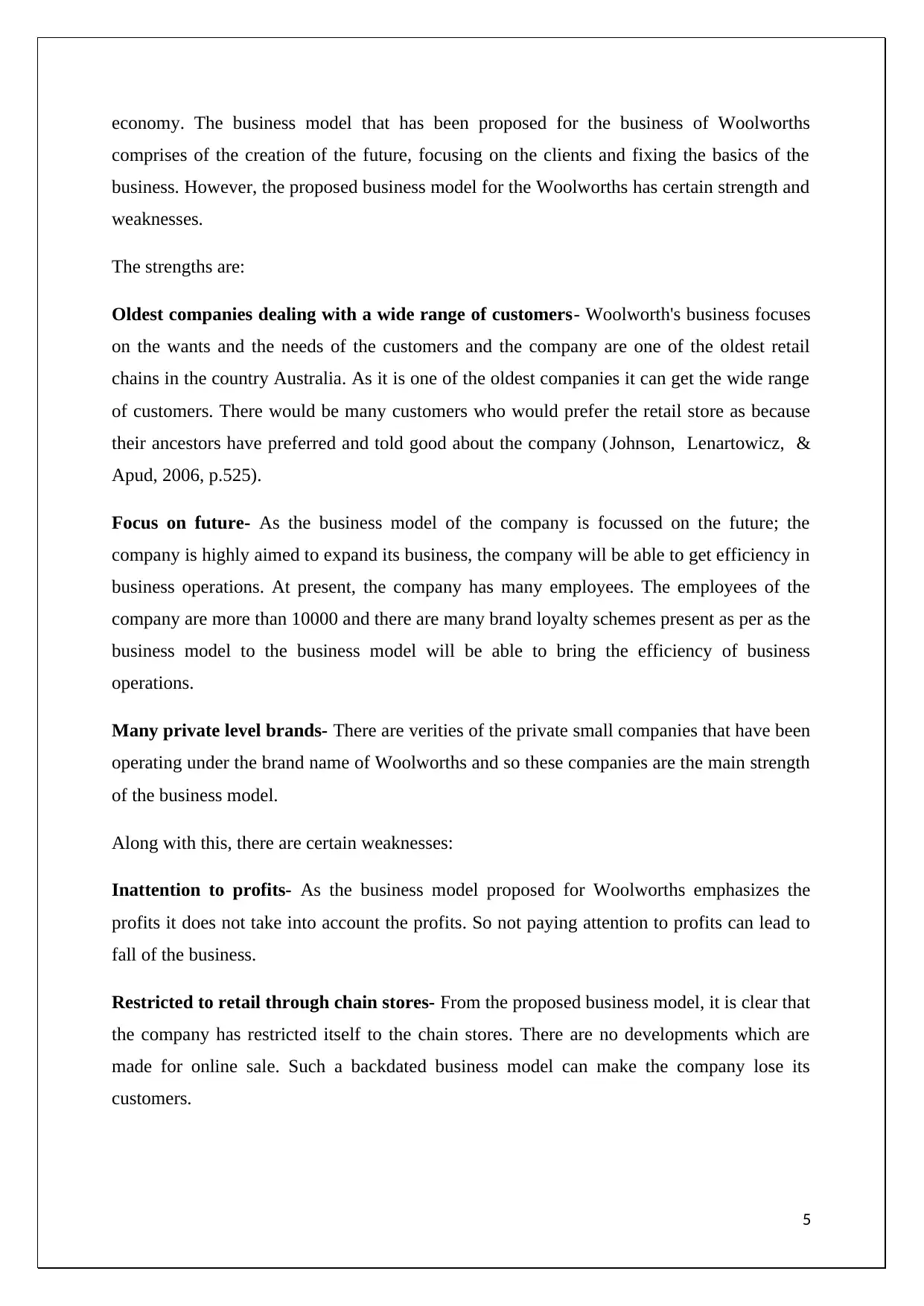
economy. The business model that has been proposed for the business of Woolworths
comprises of the creation of the future, focusing on the clients and fixing the basics of the
business. However, the proposed business model for the Woolworths has certain strength and
weaknesses.
The strengths are:
Oldest companies dealing with a wide range of customers- Woolworth's business focuses
on the wants and the needs of the customers and the company are one of the oldest retail
chains in the country Australia. As it is one of the oldest companies it can get the wide range
of customers. There would be many customers who would prefer the retail store as because
their ancestors have preferred and told good about the company (Johnson, Lenartowicz, &
Apud, 2006, p.525).
Focus on future- As the business model of the company is focussed on the future; the
company is highly aimed to expand its business, the company will be able to get efficiency in
business operations. At present, the company has many employees. The employees of the
company are more than 10000 and there are many brand loyalty schemes present as per as the
business model to the business model will be able to bring the efficiency of business
operations.
Many private level brands- There are verities of the private small companies that have been
operating under the brand name of Woolworths and so these companies are the main strength
of the business model.
Along with this, there are certain weaknesses:
Inattention to profits- As the business model proposed for Woolworths emphasizes the
profits it does not take into account the profits. So not paying attention to profits can lead to
fall of the business.
Restricted to retail through chain stores- From the proposed business model, it is clear that
the company has restricted itself to the chain stores. There are no developments which are
made for online sale. Such a backdated business model can make the company lose its
customers.
5
comprises of the creation of the future, focusing on the clients and fixing the basics of the
business. However, the proposed business model for the Woolworths has certain strength and
weaknesses.
The strengths are:
Oldest companies dealing with a wide range of customers- Woolworth's business focuses
on the wants and the needs of the customers and the company are one of the oldest retail
chains in the country Australia. As it is one of the oldest companies it can get the wide range
of customers. There would be many customers who would prefer the retail store as because
their ancestors have preferred and told good about the company (Johnson, Lenartowicz, &
Apud, 2006, p.525).
Focus on future- As the business model of the company is focussed on the future; the
company is highly aimed to expand its business, the company will be able to get efficiency in
business operations. At present, the company has many employees. The employees of the
company are more than 10000 and there are many brand loyalty schemes present as per as the
business model to the business model will be able to bring the efficiency of business
operations.
Many private level brands- There are verities of the private small companies that have been
operating under the brand name of Woolworths and so these companies are the main strength
of the business model.
Along with this, there are certain weaknesses:
Inattention to profits- As the business model proposed for Woolworths emphasizes the
profits it does not take into account the profits. So not paying attention to profits can lead to
fall of the business.
Restricted to retail through chain stores- From the proposed business model, it is clear that
the company has restricted itself to the chain stores. There are no developments which are
made for online sale. Such a backdated business model can make the company lose its
customers.
5
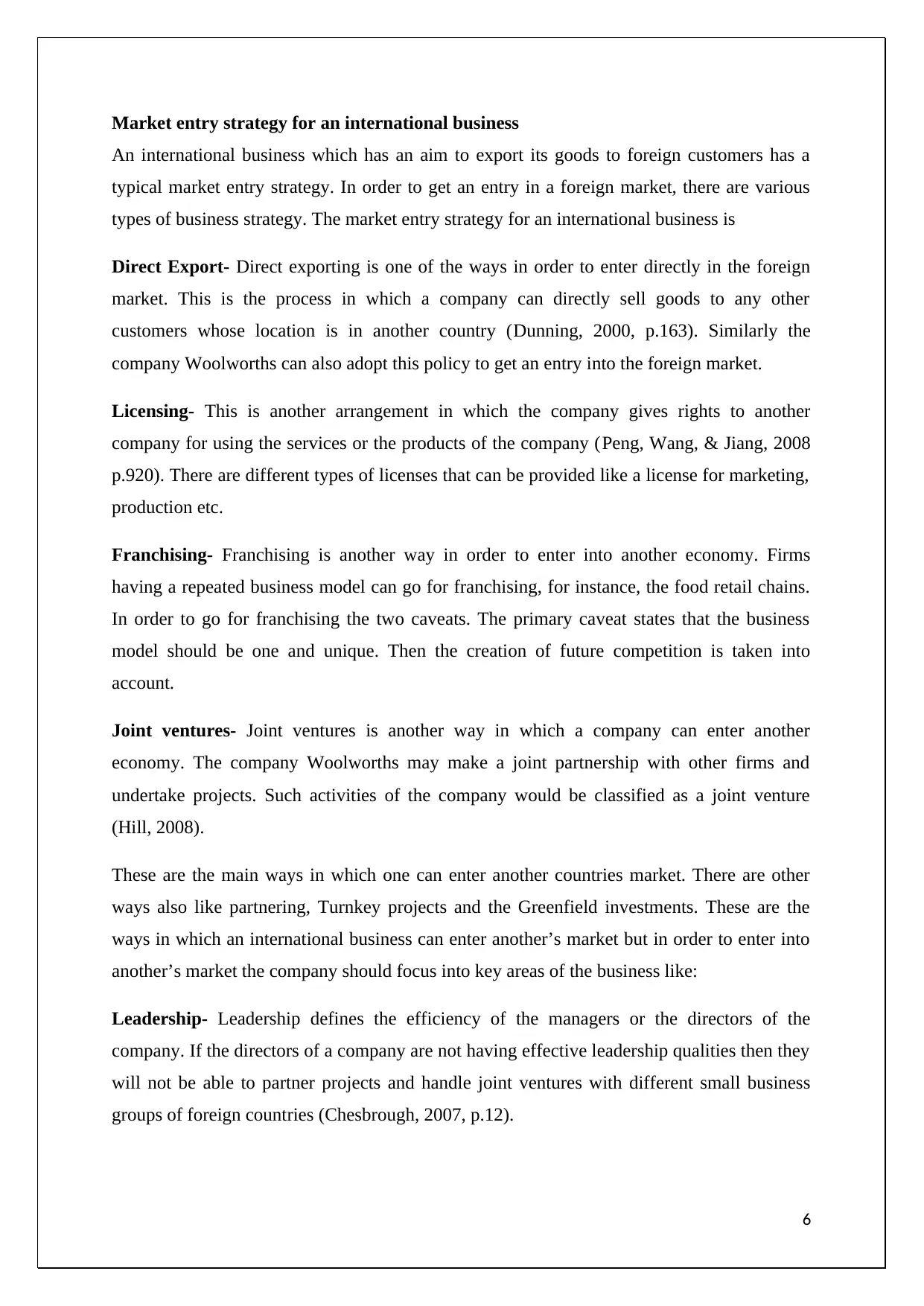
Market entry strategy for an international business
An international business which has an aim to export its goods to foreign customers has a
typical market entry strategy. In order to get an entry in a foreign market, there are various
types of business strategy. The market entry strategy for an international business is
Direct Export- Direct exporting is one of the ways in order to enter directly in the foreign
market. This is the process in which a company can directly sell goods to any other
customers whose location is in another country (Dunning, 2000, p.163). Similarly the
company Woolworths can also adopt this policy to get an entry into the foreign market.
Licensing- This is another arrangement in which the company gives rights to another
company for using the services or the products of the company (Peng, Wang, & Jiang, 2008
p.920). There are different types of licenses that can be provided like a license for marketing,
production etc.
Franchising- Franchising is another way in order to enter into another economy. Firms
having a repeated business model can go for franchising, for instance, the food retail chains.
In order to go for franchising the two caveats. The primary caveat states that the business
model should be one and unique. Then the creation of future competition is taken into
account.
Joint ventures- Joint ventures is another way in which a company can enter another
economy. The company Woolworths may make a joint partnership with other firms and
undertake projects. Such activities of the company would be classified as a joint venture
(Hill, 2008).
These are the main ways in which one can enter another countries market. There are other
ways also like partnering, Turnkey projects and the Greenfield investments. These are the
ways in which an international business can enter another’s market but in order to enter into
another’s market the company should focus into key areas of the business like:
Leadership- Leadership defines the efficiency of the managers or the directors of the
company. If the directors of a company are not having effective leadership qualities then they
will not be able to partner projects and handle joint ventures with different small business
groups of foreign countries (Chesbrough, 2007, p.12).
6
An international business which has an aim to export its goods to foreign customers has a
typical market entry strategy. In order to get an entry in a foreign market, there are various
types of business strategy. The market entry strategy for an international business is
Direct Export- Direct exporting is one of the ways in order to enter directly in the foreign
market. This is the process in which a company can directly sell goods to any other
customers whose location is in another country (Dunning, 2000, p.163). Similarly the
company Woolworths can also adopt this policy to get an entry into the foreign market.
Licensing- This is another arrangement in which the company gives rights to another
company for using the services or the products of the company (Peng, Wang, & Jiang, 2008
p.920). There are different types of licenses that can be provided like a license for marketing,
production etc.
Franchising- Franchising is another way in order to enter into another economy. Firms
having a repeated business model can go for franchising, for instance, the food retail chains.
In order to go for franchising the two caveats. The primary caveat states that the business
model should be one and unique. Then the creation of future competition is taken into
account.
Joint ventures- Joint ventures is another way in which a company can enter another
economy. The company Woolworths may make a joint partnership with other firms and
undertake projects. Such activities of the company would be classified as a joint venture
(Hill, 2008).
These are the main ways in which one can enter another countries market. There are other
ways also like partnering, Turnkey projects and the Greenfield investments. These are the
ways in which an international business can enter another’s market but in order to enter into
another’s market the company should focus into key areas of the business like:
Leadership- Leadership defines the efficiency of the managers or the directors of the
company. If the directors of a company are not having effective leadership qualities then they
will not be able to partner projects and handle joint ventures with different small business
groups of foreign countries (Chesbrough, 2007, p.12).
6
⊘ This is a preview!⊘
Do you want full access?
Subscribe today to unlock all pages.

Trusted by 1+ million students worldwide
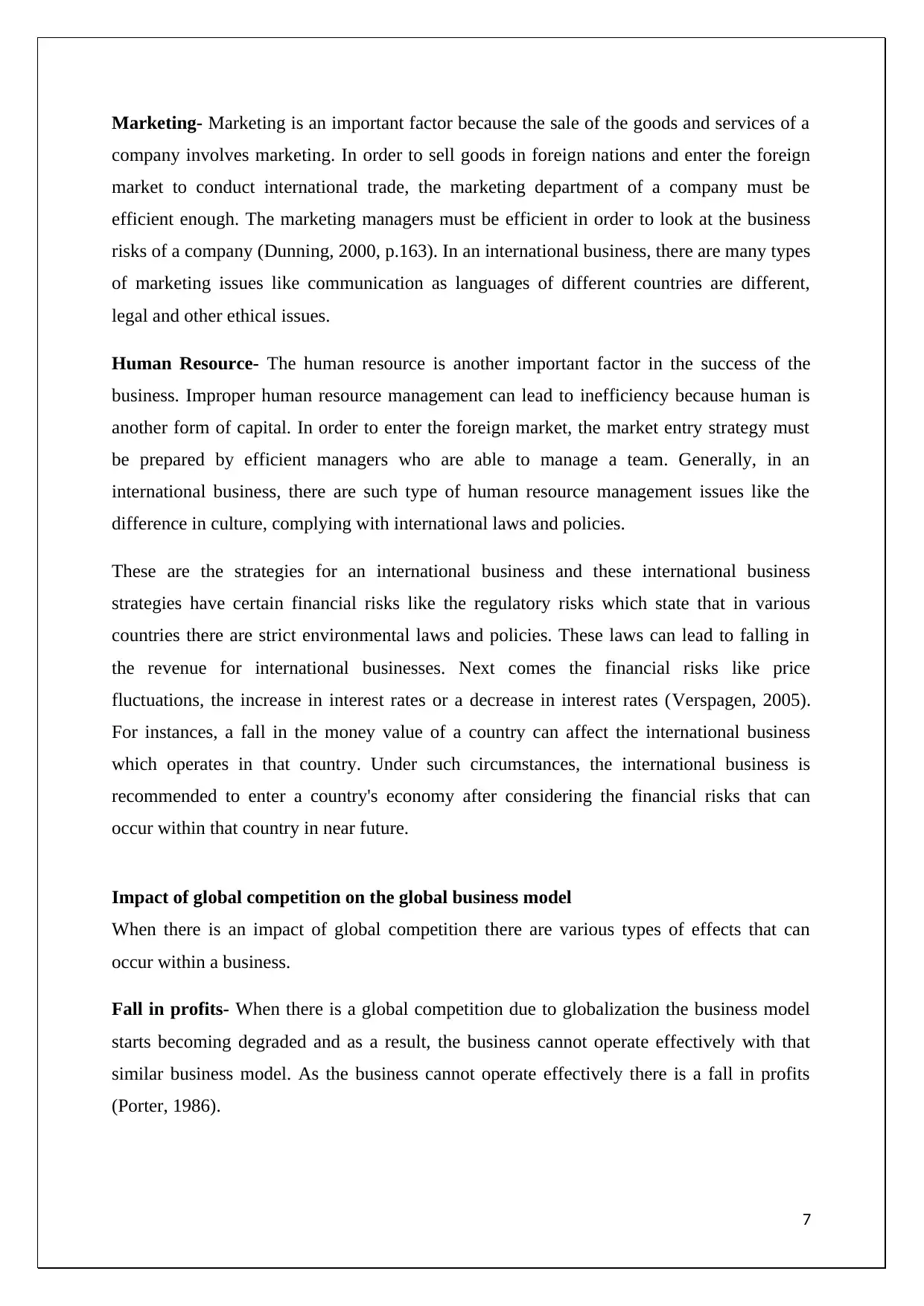
Marketing- Marketing is an important factor because the sale of the goods and services of a
company involves marketing. In order to sell goods in foreign nations and enter the foreign
market to conduct international trade, the marketing department of a company must be
efficient enough. The marketing managers must be efficient in order to look at the business
risks of a company (Dunning, 2000, p.163). In an international business, there are many types
of marketing issues like communication as languages of different countries are different,
legal and other ethical issues.
Human Resource- The human resource is another important factor in the success of the
business. Improper human resource management can lead to inefficiency because human is
another form of capital. In order to enter the foreign market, the market entry strategy must
be prepared by efficient managers who are able to manage a team. Generally, in an
international business, there are such type of human resource management issues like the
difference in culture, complying with international laws and policies.
These are the strategies for an international business and these international business
strategies have certain financial risks like the regulatory risks which state that in various
countries there are strict environmental laws and policies. These laws can lead to falling in
the revenue for international businesses. Next comes the financial risks like price
fluctuations, the increase in interest rates or a decrease in interest rates (Verspagen, 2005).
For instances, a fall in the money value of a country can affect the international business
which operates in that country. Under such circumstances, the international business is
recommended to enter a country's economy after considering the financial risks that can
occur within that country in near future.
Impact of global competition on the global business model
When there is an impact of global competition there are various types of effects that can
occur within a business.
Fall in profits- When there is a global competition due to globalization the business model
starts becoming degraded and as a result, the business cannot operate effectively with that
similar business model. As the business cannot operate effectively there is a fall in profits
(Porter, 1986).
7
company involves marketing. In order to sell goods in foreign nations and enter the foreign
market to conduct international trade, the marketing department of a company must be
efficient enough. The marketing managers must be efficient in order to look at the business
risks of a company (Dunning, 2000, p.163). In an international business, there are many types
of marketing issues like communication as languages of different countries are different,
legal and other ethical issues.
Human Resource- The human resource is another important factor in the success of the
business. Improper human resource management can lead to inefficiency because human is
another form of capital. In order to enter the foreign market, the market entry strategy must
be prepared by efficient managers who are able to manage a team. Generally, in an
international business, there are such type of human resource management issues like the
difference in culture, complying with international laws and policies.
These are the strategies for an international business and these international business
strategies have certain financial risks like the regulatory risks which state that in various
countries there are strict environmental laws and policies. These laws can lead to falling in
the revenue for international businesses. Next comes the financial risks like price
fluctuations, the increase in interest rates or a decrease in interest rates (Verspagen, 2005).
For instances, a fall in the money value of a country can affect the international business
which operates in that country. Under such circumstances, the international business is
recommended to enter a country's economy after considering the financial risks that can
occur within that country in near future.
Impact of global competition on the global business model
When there is an impact of global competition there are various types of effects that can
occur within a business.
Fall in profits- When there is a global competition due to globalization the business model
starts becoming degraded and as a result, the business cannot operate effectively with that
similar business model. As the business cannot operate effectively there is a fall in profits
(Porter, 1986).
7
Paraphrase This Document
Need a fresh take? Get an instant paraphrase of this document with our AI Paraphraser
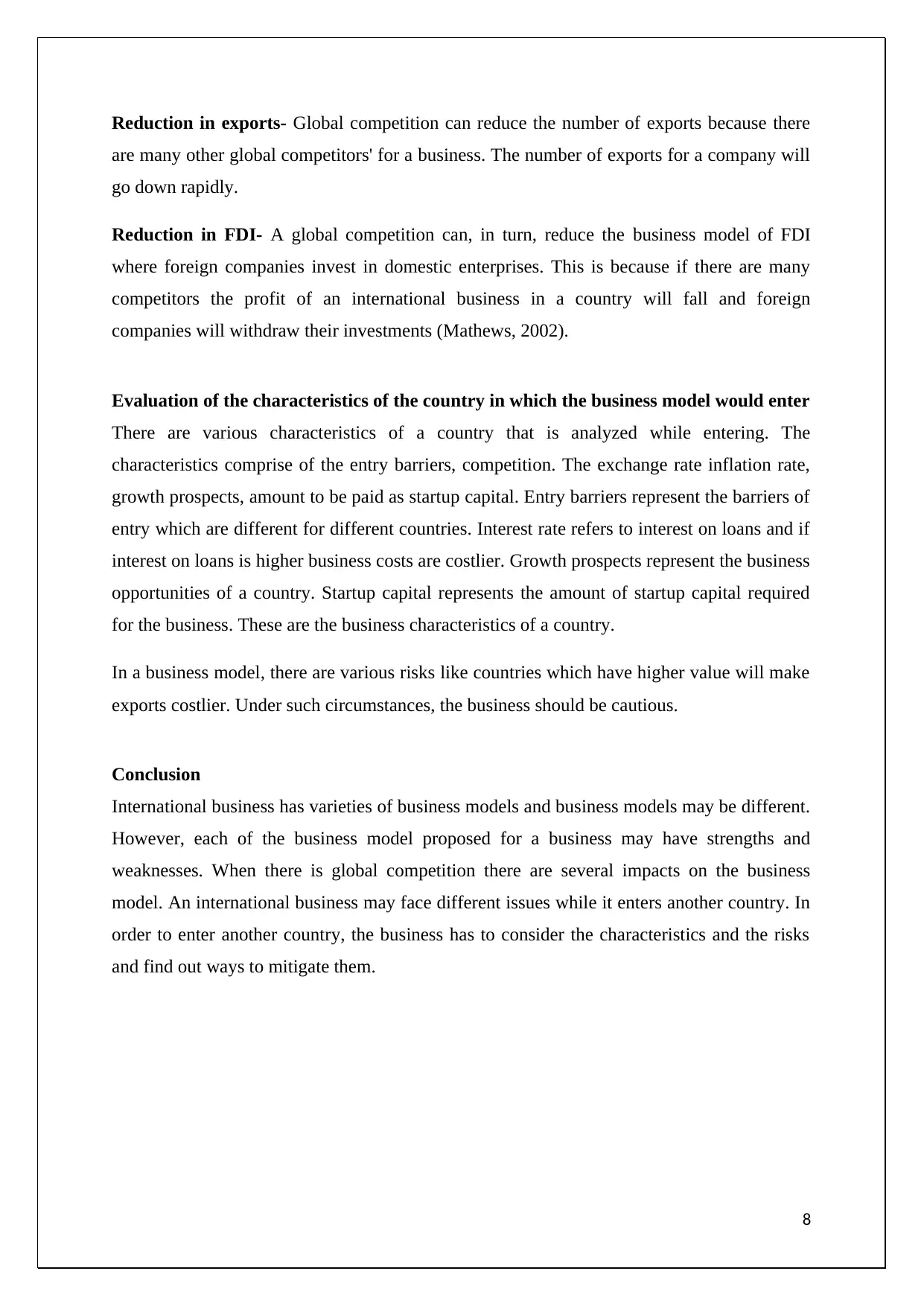
Reduction in exports- Global competition can reduce the number of exports because there
are many other global competitors' for a business. The number of exports for a company will
go down rapidly.
Reduction in FDI- A global competition can, in turn, reduce the business model of FDI
where foreign companies invest in domestic enterprises. This is because if there are many
competitors the profit of an international business in a country will fall and foreign
companies will withdraw their investments (Mathews, 2002).
Evaluation of the characteristics of the country in which the business model would enter
There are various characteristics of a country that is analyzed while entering. The
characteristics comprise of the entry barriers, competition. The exchange rate inflation rate,
growth prospects, amount to be paid as startup capital. Entry barriers represent the barriers of
entry which are different for different countries. Interest rate refers to interest on loans and if
interest on loans is higher business costs are costlier. Growth prospects represent the business
opportunities of a country. Startup capital represents the amount of startup capital required
for the business. These are the business characteristics of a country.
In a business model, there are various risks like countries which have higher value will make
exports costlier. Under such circumstances, the business should be cautious.
Conclusion
International business has varieties of business models and business models may be different.
However, each of the business model proposed for a business may have strengths and
weaknesses. When there is global competition there are several impacts on the business
model. An international business may face different issues while it enters another country. In
order to enter another country, the business has to consider the characteristics and the risks
and find out ways to mitigate them.
8
are many other global competitors' for a business. The number of exports for a company will
go down rapidly.
Reduction in FDI- A global competition can, in turn, reduce the business model of FDI
where foreign companies invest in domestic enterprises. This is because if there are many
competitors the profit of an international business in a country will fall and foreign
companies will withdraw their investments (Mathews, 2002).
Evaluation of the characteristics of the country in which the business model would enter
There are various characteristics of a country that is analyzed while entering. The
characteristics comprise of the entry barriers, competition. The exchange rate inflation rate,
growth prospects, amount to be paid as startup capital. Entry barriers represent the barriers of
entry which are different for different countries. Interest rate refers to interest on loans and if
interest on loans is higher business costs are costlier. Growth prospects represent the business
opportunities of a country. Startup capital represents the amount of startup capital required
for the business. These are the business characteristics of a country.
In a business model, there are various risks like countries which have higher value will make
exports costlier. Under such circumstances, the business should be cautious.
Conclusion
International business has varieties of business models and business models may be different.
However, each of the business model proposed for a business may have strengths and
weaknesses. When there is global competition there are several impacts on the business
model. An international business may face different issues while it enters another country. In
order to enter another country, the business has to consider the characteristics and the risks
and find out ways to mitigate them.
8
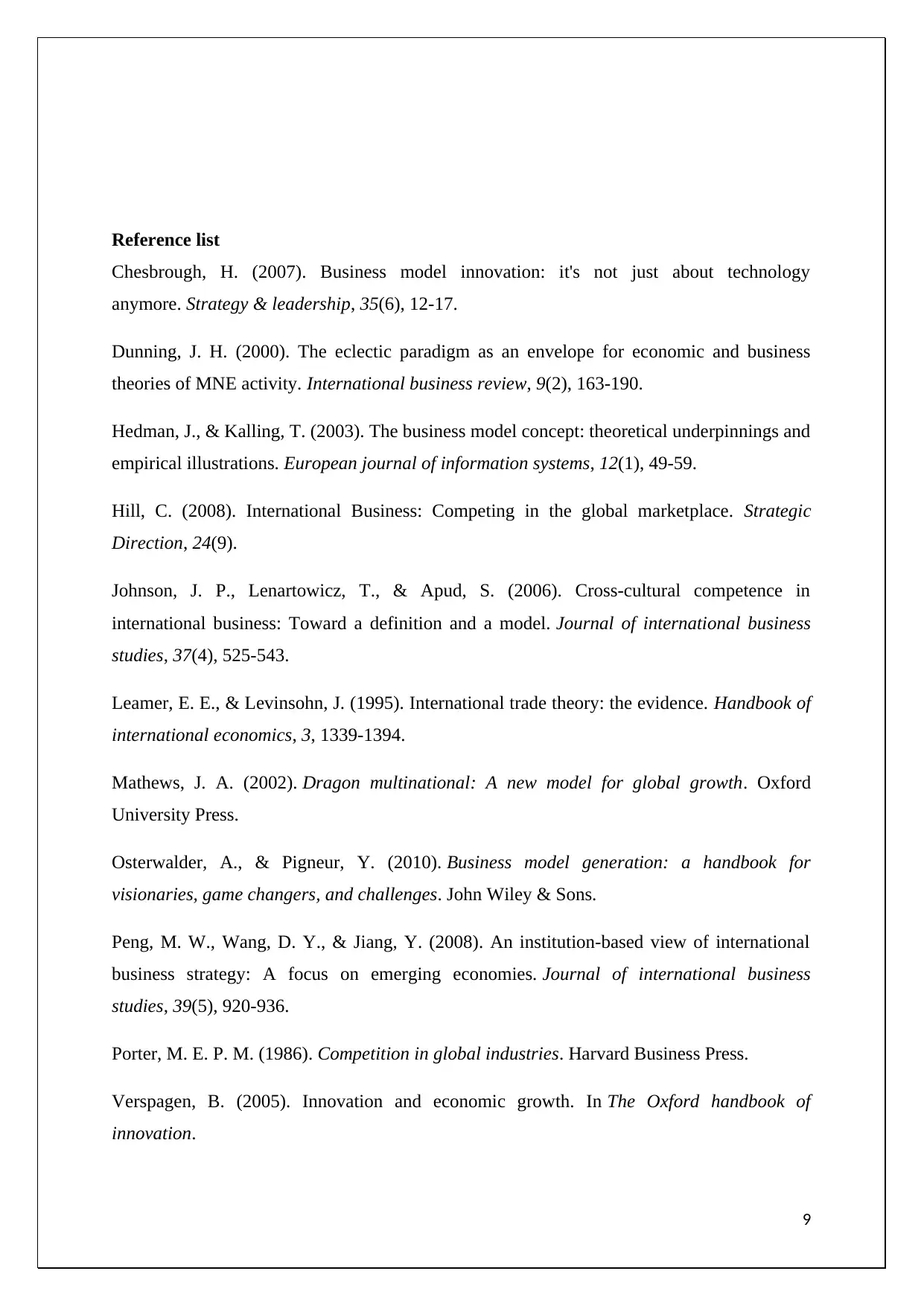
Reference list
Chesbrough, H. (2007). Business model innovation: it's not just about technology
anymore. Strategy & leadership, 35(6), 12-17.
Dunning, J. H. (2000). The eclectic paradigm as an envelope for economic and business
theories of MNE activity. International business review, 9(2), 163-190.
Hedman, J., & Kalling, T. (2003). The business model concept: theoretical underpinnings and
empirical illustrations. European journal of information systems, 12(1), 49-59.
Hill, C. (2008). International Business: Competing in the global marketplace. Strategic
Direction, 24(9).
Johnson, J. P., Lenartowicz, T., & Apud, S. (2006). Cross-cultural competence in
international business: Toward a definition and a model. Journal of international business
studies, 37(4), 525-543.
Leamer, E. E., & Levinsohn, J. (1995). International trade theory: the evidence. Handbook of
international economics, 3, 1339-1394.
Mathews, J. A. (2002). Dragon multinational: A new model for global growth. Oxford
University Press.
Osterwalder, A., & Pigneur, Y. (2010). Business model generation: a handbook for
visionaries, game changers, and challenges. John Wiley & Sons.
Peng, M. W., Wang, D. Y., & Jiang, Y. (2008). An institution-based view of international
business strategy: A focus on emerging economies. Journal of international business
studies, 39(5), 920-936.
Porter, M. E. P. M. (1986). Competition in global industries. Harvard Business Press.
Verspagen, B. (2005). Innovation and economic growth. In The Oxford handbook of
innovation.
9
Chesbrough, H. (2007). Business model innovation: it's not just about technology
anymore. Strategy & leadership, 35(6), 12-17.
Dunning, J. H. (2000). The eclectic paradigm as an envelope for economic and business
theories of MNE activity. International business review, 9(2), 163-190.
Hedman, J., & Kalling, T. (2003). The business model concept: theoretical underpinnings and
empirical illustrations. European journal of information systems, 12(1), 49-59.
Hill, C. (2008). International Business: Competing in the global marketplace. Strategic
Direction, 24(9).
Johnson, J. P., Lenartowicz, T., & Apud, S. (2006). Cross-cultural competence in
international business: Toward a definition and a model. Journal of international business
studies, 37(4), 525-543.
Leamer, E. E., & Levinsohn, J. (1995). International trade theory: the evidence. Handbook of
international economics, 3, 1339-1394.
Mathews, J. A. (2002). Dragon multinational: A new model for global growth. Oxford
University Press.
Osterwalder, A., & Pigneur, Y. (2010). Business model generation: a handbook for
visionaries, game changers, and challenges. John Wiley & Sons.
Peng, M. W., Wang, D. Y., & Jiang, Y. (2008). An institution-based view of international
business strategy: A focus on emerging economies. Journal of international business
studies, 39(5), 920-936.
Porter, M. E. P. M. (1986). Competition in global industries. Harvard Business Press.
Verspagen, B. (2005). Innovation and economic growth. In The Oxford handbook of
innovation.
9
⊘ This is a preview!⊘
Do you want full access?
Subscribe today to unlock all pages.

Trusted by 1+ million students worldwide
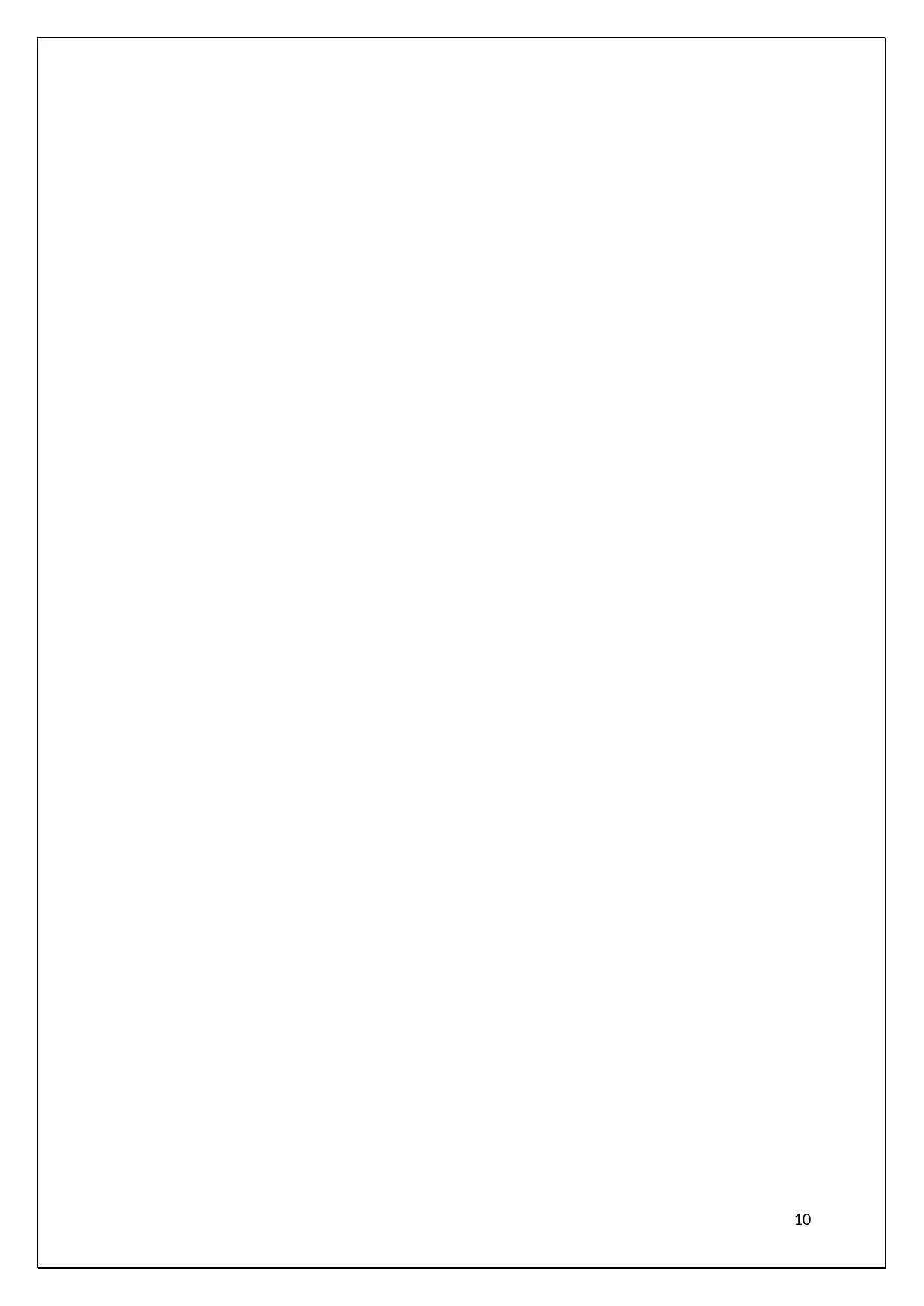
10
1 out of 10
Related Documents
Your All-in-One AI-Powered Toolkit for Academic Success.
+13062052269
info@desklib.com
Available 24*7 on WhatsApp / Email
![[object Object]](/_next/static/media/star-bottom.7253800d.svg)
Unlock your academic potential
Copyright © 2020–2025 A2Z Services. All Rights Reserved. Developed and managed by ZUCOL.



